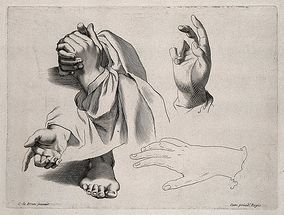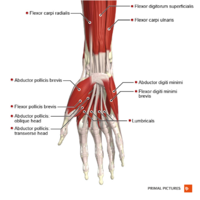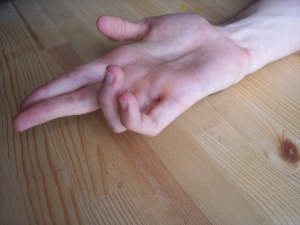Benediction Hand (aka Benediction Sign or Preacher's Hand): Difference between revisions
No edit summary |
Kim Jackson (talk | contribs) m (Text replacement - "brachial plexus" to "brachial plexus") |
||
| (14 intermediate revisions by 3 users not shown) | |||
| Line 4: | Line 4: | ||
'''Top Contributors''' - {{Special:Contributors/{{FULLPAGENAME}}}} | '''Top Contributors''' - {{Special:Contributors/{{FULLPAGENAME}}}} | ||
</div> | </div> | ||
== Description == | == Description == | ||
[[File:Benediction hand.jpg|thumb|284x284px]]The Benediction Sign is the result of peripheral neuropathy affecting musculature in the hand. It is seen when the patient is asked to make a fist and the ring and little finger flex but the index and middle finger can | [[File:Benediction hand.jpg|thumb|284x284px]]The Benediction Sign is the result of peripheral neuropathy affecting musculature in the hand. It is seen when the patient is asked to make a fist and the ring and little finger flex but the index and middle finger can not flex at the metacarpal-phalangeal joint or [[Interphalangeal Joints of the Hand|interphalangeal joint]]. | ||
There is some controversy as to the source of the Benediction Sign for many years, specifically if the median nerve or the ulnar nerve is involved<ref name="Futterman" />. According to Futterman, <ref name="Futterman">Futterman B. Analysis of the Papal Benediction Sign: | There is some controversy as to the source of the Benediction Sign for many years, specifically if the median nerve or the ulnar nerve is involved<ref name="Futterman" />. According to Futterman, <ref name="Futterman">Futterman B. Analysis of the Papal Benediction Sign: the ulnar neuropathy of St. Peter. Clinical Anatomy. 2015 Sep;28(6):696-701.</ref> the desired position of the hand during a blessing or benediction would typically have been an open position with the fingers extended. In fact, he notes that the 4th and 5th digits would have been abducted from the second and third digits (similar to the hand sign used by Vulcans in the Star Trek TV and movie series). <ref name="Futterman" /> Based on this author's research of cultural artwork, he asserts that Peter, the first Pope, had an ulnar neuropathy which limited Peter's ability to perform the then-traditional open hand blessing and has led to the hand position that has since become the norm for giving blessings.<ref name="Futterman" /><br> | ||
In the presence of [[Ulnar Nerve Entrapment|ulnar neuropathy]], the function of the interossei and lumbrical muscles to the 4th and 5th digits would be compromised, thus the 4th and 5th digits could not abduct from the midline of the hand (interossei function) nor could those fingers flex at the MCP joints or extend at the IP joints (lumbrical function). Extensor digitorum (innervated by the radial nerve) acts primarily on the MCP joint, not the IP joints, therefore it could not extend the IP joints to compensate for the loss of lumbrical function. | In the presence of [[Ulnar Nerve Entrapment|ulnar neuropathy]], the function of the interossei and [[Lumbricals of the Hand|lumbrical]] muscles to the 4th and 5th digits would be compromised, thus the 4th and 5th digits could not abduct from the midline of the hand (interossei function) nor could those fingers flex at the MCP joints or extend at the IP joints (lumbrical function). [[Extensor Digitorum Communis|Extensor digitorum]] (innervated by the [[radial nerve]]) acts primarily on the metacarpophalangeal (MCP) joint, not the interphalangeal (IP) joints, therefore it could not extend the IP joints to compensate for the loss of lumbrical function. <ref>Extensor digitorum muscle. Available from: https://en.wikipedia.org/wiki/Extensor_digitorum_muscle ( Last accessed, 13/02/2016).</ref> As a result, during an attempt to extend the 4th and 5th digits (as in the open hand blessing described above) the MCP joints be extended but the IP joints would stay flexed. <br> | ||
Futterman <ref name="Futterman" /> notes that Benediction Sign is often described as a median nerve injury because this would result in an inability to perform flexion at the MCP and IP joints of the 2nd and 3rd digits. However, he notes that this would only make sense if the injured person was trying to make a fist and since a fist is not a historically-known sign of blessing or greeting, Benediction Sign must stem from an ulnar neuropathy and the subsequent inability to fully open the hand. <br> | Futterman <ref name="Futterman" /> notes that Benediction Sign is often described as a [[Median Nerve|median nerve]] injury because this would result in an inability to perform flexion at the MCP and IP joints of the 2nd and 3rd digits. However, he notes that this would only make sense if the injured person was trying to make a fist and since a fist is not a historically-known sign of blessing or greeting, Benediction Sign must stem from an ulnar neuropathy and the subsequent inability to fully open the hand. <br> | ||
== | ==Clinically Relevant Anatomy== | ||
[[File: | [[File:Muscles_of_the_hand_anterior_aspect_Primal.png|thumb|200x200px]] | ||
The [https://physio-pedia.com/Ulnar_Nerve?utm_source=physiopedia&utm_medium=search&utm_campaign=ongoing_internal ulnar nerve] originates from the terminal branch of the medial cord of the [[brachial plexus]] and contains fibers from C8, T1, and, occasionally, C7. It innervates muscles in the anterior compartment of the forearm; [https://physio-pedia.com/Flexor_Carpi_Ulnaris_Muscle?utm_source=physiopedia&utm_medium=search&utm_campaign=ongoing_internal Flexor carpi ulnaris] and medial half of [https://physio-pedia.com/Flexor_Digitorum_Profundus?utm_source=physiopedia&utm_medium=search&utm_campaign=ongoing_internal Flexor digitorum profundus], and muscles of the hand; Hypothenar muscle, Medial two lumbricals, Adductor pollicis, [[Palmar Interossei|Palmar]] and [https://physio-pedia.com/Dorsal_Interossei_of_the_hand dorsal interossei] of the hand, and Palmaris Brevis. | The [https://physio-pedia.com/Ulnar_Nerve?utm_source=physiopedia&utm_medium=search&utm_campaign=ongoing_internal ulnar nerve] originates from the terminal branch of the medial cord of the [[Brachial Plexus|brachial plexus]] and contains fibers from C8, T1, and, occasionally, C7. It innervates muscles in the anterior compartment of the forearm; [https://physio-pedia.com/Flexor_Carpi_Ulnaris_Muscle?utm_source=physiopedia&utm_medium=search&utm_campaign=ongoing_internal Flexor carpi ulnaris] and medial half of [https://physio-pedia.com/Flexor_Digitorum_Profundus?utm_source=physiopedia&utm_medium=search&utm_campaign=ongoing_internal Flexor digitorum profundus], and muscles of the hand; [https://physio-pedia.com/Thenar_and_Hypothenar_Muscles_Of_The_Hand?utm_source=physiopedia&utm_medium=search&utm_campaign=ongoing_internal Hypothenar muscle], Medial two lumbricals, Adductor pollicis, [[Palmar Interossei|Palmar]] and [https://physio-pedia.com/Dorsal_Interossei_of_the_hand dorsal interossei] of the hand, and Palmaris Brevis. | ||
For more detailed information on the [https://physio-pedia.com/Ulnar_Nerve?utm_source=physiopedia&utm_medium=search&utm_campaign=ongoing_internal anatomy of the ulnar nerve] | For more detailed information on the [https://physio-pedia.com/Ulnar_Nerve?utm_source=physiopedia&utm_medium=search&utm_campaign=ongoing_internal anatomy of the ulnar nerve] | ||
| Line 27: | Line 25: | ||
<ref>Floranda EE, Jacobs BC. [https://www.ncbi.nlm.nih.gov/pubmed/24209726 Evaluation and treatment of upper extremity nerve entrapment syndromes]. Primary care. 2013 Dec;40(4):925.</ref>[[Image:Benediction hand ulnar claw.JPG|center|300px]] | <ref>Floranda EE, Jacobs BC. [https://www.ncbi.nlm.nih.gov/pubmed/24209726 Evaluation and treatment of upper extremity nerve entrapment syndromes]. Primary care. 2013 Dec;40(4):925.</ref>[[Image:Benediction hand ulnar claw.JPG|center|300px]] | ||
== | == Differential Diagnosis == | ||
< | Benediction hand indicates peripheral neuropathy, most likely an ulnar neuropathy and on physical examination, other clinical presentations associated with ulnar neuropathy could be observable. These include:<ref>Alsaffar RM, Hameed S. [https://www.ncbi.nlm.nih.gov/books/NBK554458/ Benediction Hand (Benediction Sign, Preachers Hand)]. InStatPearls [Internet] 2020 Mar 1. StatPearls Publishing.</ref> | ||
* [https://physio-pedia.com/Froment%E2%80%99s_Sign?utm_source=physiopedia&utm_medium=search&utm_campaign=ongoing_internal Froment sign] | |||
* [https://physio-pedia.com/Wartenberg's_Sign?utm_source=physiopedia&utm_medium=search&utm_campaign=ongoing_internal Wartenberg sign] | |||
* Atrophy of the intrinsic muscles ( [https://physio-pedia.com/Thenar_and_Hypothenar_Muscles_Of_The_Hand?utm_source=physiopedia&utm_medium=search&utm_campaign=ongoing_internal# the hypothenar muscles]) | |||
== Management and Treatment == | |||
The treatment of Benediction Hand involves the management and treatment of ulnar and median nerve neuropathies by using: <ref>Hand of Benediction. What Is It, Causes, and More. Available from: <nowiki>https://www.osmosis.org/answers/hand-of-benediction</nowiki> ( Accessed, 19/07/2021).</ref> | |||
* Non-steroidal inflammatory drugs (NSAIDs) to control pain and prevent symptoms to get worse. | |||
* An arm or wrist brace to avoid nerve compression and excessive bending. | |||
* [[Hand Exercises|Hand stretching and strengthening exercises]] with a Physiotherapist or Occupational Therapist if needed. | |||
* Nerve decompression surgery to reduce pressure and relieve pain if the median nerve is affected because of the [[Carpal Tunnel Syndrome]]. | |||
{{#ev:youtube|0AAligXLJ1A |300}}<ref>FSUMedMedia. Claw Hand, Ape Hand, and the Sign of Benediction: Animated Review. Available from: https://www.youtube.com/watch?v=0AAligXLJ1A [Accessed, 19/07/2021]</ref> | |||
== References == | == References == | ||
Revision as of 19:02, 8 March 2024
Original Editor -Pamela Gonzalez
Top Contributors - Laura Ritchie, Aminat Abolade, Kirenga Bamurange Liliane, Admin, Kim Jackson, Pamela Gonzalez, Rachael Lowe, David Adamson, WikiSysop, Lauren Kwant, Evan Thomas and Richard Benes
Description[edit | edit source]
The Benediction Sign is the result of peripheral neuropathy affecting musculature in the hand. It is seen when the patient is asked to make a fist and the ring and little finger flex but the index and middle finger can not flex at the metacarpal-phalangeal joint or interphalangeal joint.
There is some controversy as to the source of the Benediction Sign for many years, specifically if the median nerve or the ulnar nerve is involved[1]. According to Futterman, [1] the desired position of the hand during a blessing or benediction would typically have been an open position with the fingers extended. In fact, he notes that the 4th and 5th digits would have been abducted from the second and third digits (similar to the hand sign used by Vulcans in the Star Trek TV and movie series). [1] Based on this author's research of cultural artwork, he asserts that Peter, the first Pope, had an ulnar neuropathy which limited Peter's ability to perform the then-traditional open hand blessing and has led to the hand position that has since become the norm for giving blessings.[1]
In the presence of ulnar neuropathy, the function of the interossei and lumbrical muscles to the 4th and 5th digits would be compromised, thus the 4th and 5th digits could not abduct from the midline of the hand (interossei function) nor could those fingers flex at the MCP joints or extend at the IP joints (lumbrical function). Extensor digitorum (innervated by the radial nerve) acts primarily on the metacarpophalangeal (MCP) joint, not the interphalangeal (IP) joints, therefore it could not extend the IP joints to compensate for the loss of lumbrical function. [2] As a result, during an attempt to extend the 4th and 5th digits (as in the open hand blessing described above) the MCP joints be extended but the IP joints would stay flexed.
Futterman [1] notes that Benediction Sign is often described as a median nerve injury because this would result in an inability to perform flexion at the MCP and IP joints of the 2nd and 3rd digits. However, he notes that this would only make sense if the injured person was trying to make a fist and since a fist is not a historically-known sign of blessing or greeting, Benediction Sign must stem from an ulnar neuropathy and the subsequent inability to fully open the hand.
Clinically Relevant Anatomy[edit | edit source]
The ulnar nerve originates from the terminal branch of the medial cord of the brachial plexus and contains fibers from C8, T1, and, occasionally, C7. It innervates muscles in the anterior compartment of the forearm; Flexor carpi ulnaris and medial half of Flexor digitorum profundus, and muscles of the hand; Hypothenar muscle, Medial two lumbricals, Adductor pollicis, Palmar and dorsal interossei of the hand, and Palmaris Brevis.
For more detailed information on the anatomy of the ulnar nerve
Clinical Presentation[edit | edit source]
Benediction Hand is presented with numbness of the fourth and fifth fingers and hand muscle weakness. The 4th and 5th fingers show a clawed-like appearance, with hyperextension at the metacarpophalangeal (MCP) joints and flexion of the proximal and distal interphalangeal (IP) joints, and the fingers and thumb are held slightly abducted. Tenderness or pain may be observed at the medial wrist or medial elbow region.
Differential Diagnosis[edit | edit source]
Benediction hand indicates peripheral neuropathy, most likely an ulnar neuropathy and on physical examination, other clinical presentations associated with ulnar neuropathy could be observable. These include:[4]
- Atrophy of the intrinsic muscles ( the hypothenar muscles)
Management and Treatment[edit | edit source]
The treatment of Benediction Hand involves the management and treatment of ulnar and median nerve neuropathies by using: [5]
- Non-steroidal inflammatory drugs (NSAIDs) to control pain and prevent symptoms to get worse.
- An arm or wrist brace to avoid nerve compression and excessive bending.
- Hand stretching and strengthening exercises with a Physiotherapist or Occupational Therapist if needed.
- Nerve decompression surgery to reduce pressure and relieve pain if the median nerve is affected because of the Carpal Tunnel Syndrome.
References[edit | edit source]
- ↑ 1.0 1.1 1.2 1.3 1.4 Futterman B. Analysis of the Papal Benediction Sign: the ulnar neuropathy of St. Peter. Clinical Anatomy. 2015 Sep;28(6):696-701.
- ↑ Extensor digitorum muscle. Available from: https://en.wikipedia.org/wiki/Extensor_digitorum_muscle ( Last accessed, 13/02/2016).
- ↑ Floranda EE, Jacobs BC. Evaluation and treatment of upper extremity nerve entrapment syndromes. Primary care. 2013 Dec;40(4):925.
- ↑ Alsaffar RM, Hameed S. Benediction Hand (Benediction Sign, Preachers Hand). InStatPearls [Internet] 2020 Mar 1. StatPearls Publishing.
- ↑ Hand of Benediction. What Is It, Causes, and More. Available from: https://www.osmosis.org/answers/hand-of-benediction ( Accessed, 19/07/2021).
- ↑ FSUMedMedia. Claw Hand, Ape Hand, and the Sign of Benediction: Animated Review. Available from: https://www.youtube.com/watch?v=0AAligXLJ1A [Accessed, 19/07/2021]









